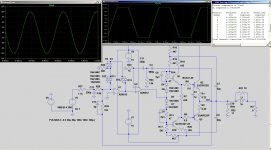Trivia: the US Navy found out about practical limits to slew rate of their ship-mounted anti-aircraft guns, when they found the guns couldn't slew fast enough to track and kill Japanese fighters. So, naturally, they upped the power and speed of the gun drives, only to find out that the guns overshot the commanded position or even started to mechanically oscillate! They enlisted Bell Labs to find out what's going on and fix it, and Bell Labs dispatched a guy by the name of Hendrik Bode.
Hendrik found out those drive amps needed compensation to be both fast and stable, and wrote a book about it. I own the 1947 edition.
That's the reason we talk about Bode plots to this day. Fascinating.
https://www.amazon.com/Network-analysis-feedback-amplifier-design/dp/0882752421
https://www.amazon.com/Pieces-Actio...82-9978-2f9a8bb30a3a&pd_rd_i=1953953204&psc=1
Jan
Hendrik found out those drive amps needed compensation to be both fast and stable, and wrote a book about it. I own the 1947 edition.
That's the reason we talk about Bode plots to this day. Fascinating.
https://www.amazon.com/Network-analysis-feedback-amplifier-design/dp/0882752421
https://www.amazon.com/Pieces-Actio...82-9978-2f9a8bb30a3a&pd_rd_i=1953953204&psc=1
Jan
Interesting story Jan - Bode’s work (and Harold Black who discovered feedback) are amongst the most important in electrical engineering. Closer to home, I read up about Bart Locanthi who designed the JBL SA600 amplifier launched in 1966. It was one of the first, if not the first, to deal with compensation in a way that we recognise today as being correct ie he considered stability, slewing and the limits of feedback. I wondered come he was so far ahead of the curve and then discovered he worked on gun control servo’s in the 1950’s for the US Navy. The knowledge from that branch of engineering about feedback and slewing limitations did not percolate into mainstream audio engineering until well into the 1980’s with just a very few people really understanding what was going on before then - Bob Cordell being one of them.
https://hifisonix.com/the-sa-600-amplifier/
https://hifisonix.com/the-sa-600-amplifier/
I’d drop the term “infinitely” but otherwise this must be true as our hearing is more acute at sensing errors than most T&M equipment.I don't believe many people understand the complexity of music wave form fidelity as it is infinitely more complex than what most tests use.
If you put a second operational amplifier and then the distortion will decrease - 0.000019%.
This amplifier can be used for headphones or small 10 watt monitors.
I also checked with OPA2134 - 0.000009% THD in the simulator.
This amplifier can be used for headphones or small 10 watt monitors.
I also checked with OPA2134 - 0.000009% THD in the simulator.
Attachments
An important consideration is whether a system can behave ideally with a simple signal and still fail with a more complex signal. If that's not possible, then there is no drawback to testing with a simple signal. In fact, testing using a simpler signal practically has more sensitivity to subtle distortions, so despite it being a simpler signal, such a test may actually be more sensitive.I’d drop the term “infinitely” but otherwise this must be true as our hearing is more acute at sensing errors than most T&M equipment.
The whole issue is nonlinearity, and given that a complex signal can be made up of a linear superposition of simple signals, there's no reason to expect simple signals to be insufficient. If a system is nonlinear, it cannot pass a simple or complex signal without alteration. Given that our current equipment can test sine waves to a much higher sensitivity than other test signals, it seems that sine waves, despite their simplicity, could be better suited to detecting nonlinearity.
You are fully correct, but some signals are better to detect a non-linearity than others. A single tone FFT for instance does not give you a lot of info on phase and polarity relationships between the components. IMD signals give a different type of info in the intermod products, while multitones give another rich set of info, like noise in the presence of sinals.
But yes, the non-linearity is what it is and does not change with test signals.
Jan
But yes, the non-linearity is what it is and does not change with test signals.
Jan
Are you sure?But yes, the non-linearity is what it is and does not change with test signals.
Nonlinearity isn't the only problem, but when talking about distortion, the cause is nonlinearity. There is no other way to get sum or difference tones or harmonics except through a nonlinear transmission path. Equalization or level errors can be fixed, distortion cannot. Once distortion has been added, it is exceedingly difficult to remove it. EQ and gain errors are simple to fix.Are you sure?
What else is there (for plain Jane circuitry)? You seem to want to state something to that effect. Don't hold back! 🙂
Is it possible?An important consideration is whether a system can behave ideally with a simple signal and still fail with a more complex signal. If that's not possible, then there is no drawback to testing with a simple signal.
I’m just pointing out some assumptions that I don’t think are proven. 🙂
- Home
- Amplifiers
- Solid State
- rise/fall time and THD
